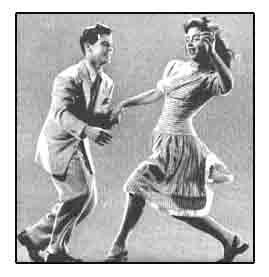Development
kurt lichtmann
Growth: Regional dance styles
grow not only because of a common musical base (local bands and radio stations),
but also because people tend to copy the outstanding individuals in a dance
hall. And, as people travel from one region to another, they pick up dance
ideas, return home with them, and leave off some their own ideas with their
hosts. Television and movie theatres have certainly played a significant role
in popularization and cross-pollination of swing dance styles. 
A very popular swing dance style could be expected to influence many regional and personal styles. However, to call ONE style the "origin" of all others might be a bit short on perspective. As Big Band Swing came to dominate the popular music scene in the '30s and '40s, its predecessor forms of Jump Blues, Ragtime piano, and Dixieland continued to flourish and develop. Similarly, although Frank Manning's ultra-performance Lindy Hop style was highly influential, with many spin-off variants, there were also parallel developments. (With all the creative talent in the Savoy Ballroom, would you expect to find a homogeneity of style across its glorious 4000-capacity dance floor?)
Sub-styles: Some of the swing dance sub-styles are highly personal. Some never expand beyond a small group, or achieve codification with a specific set of named moves, or are taught in classes. Many never have characteristic names, or make it to the movies, or survive the change of generations. But for the individuals dancing, and for those who enjoy watching, these styles are every bit as "valid" as the big popular styles.